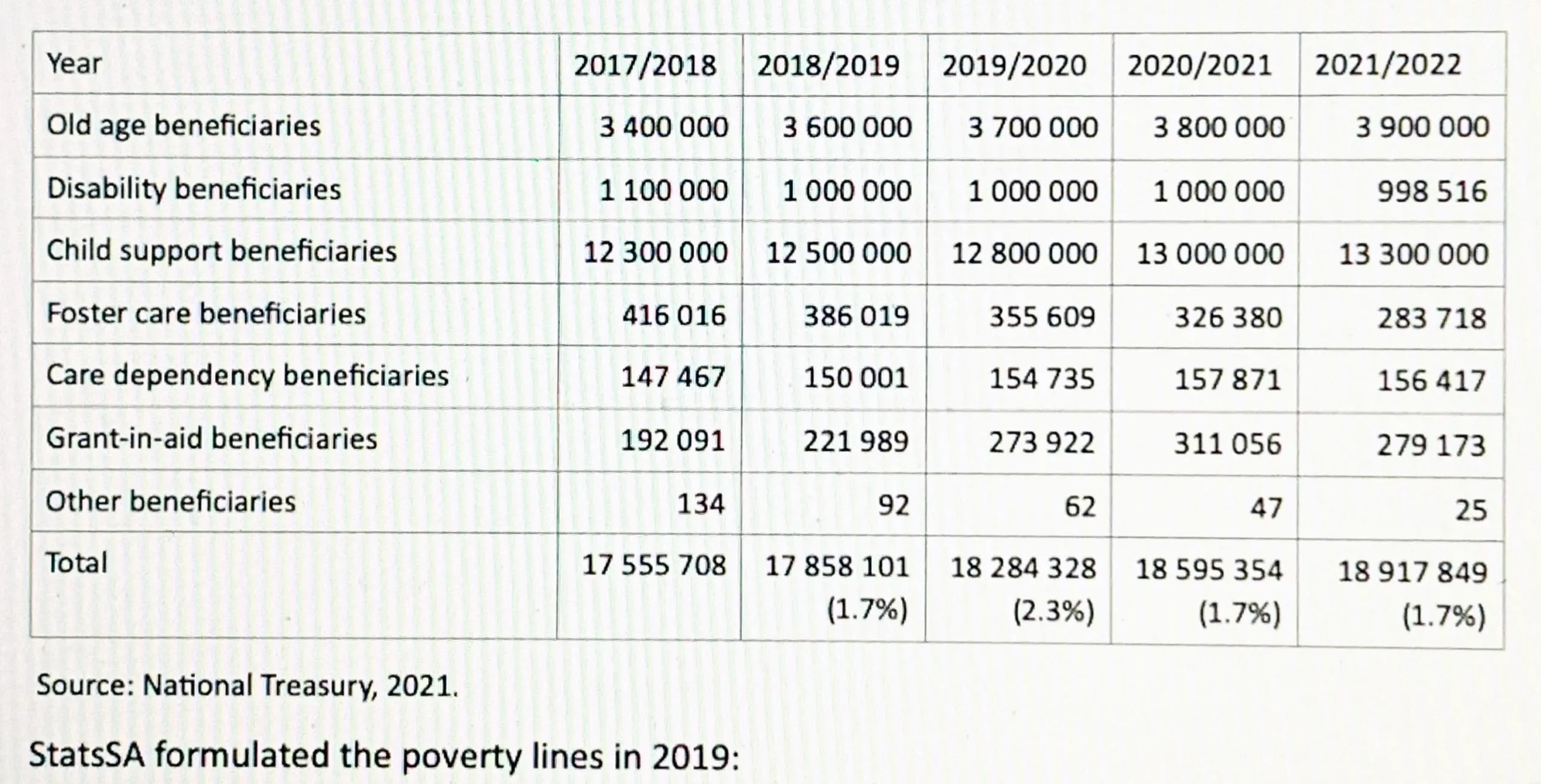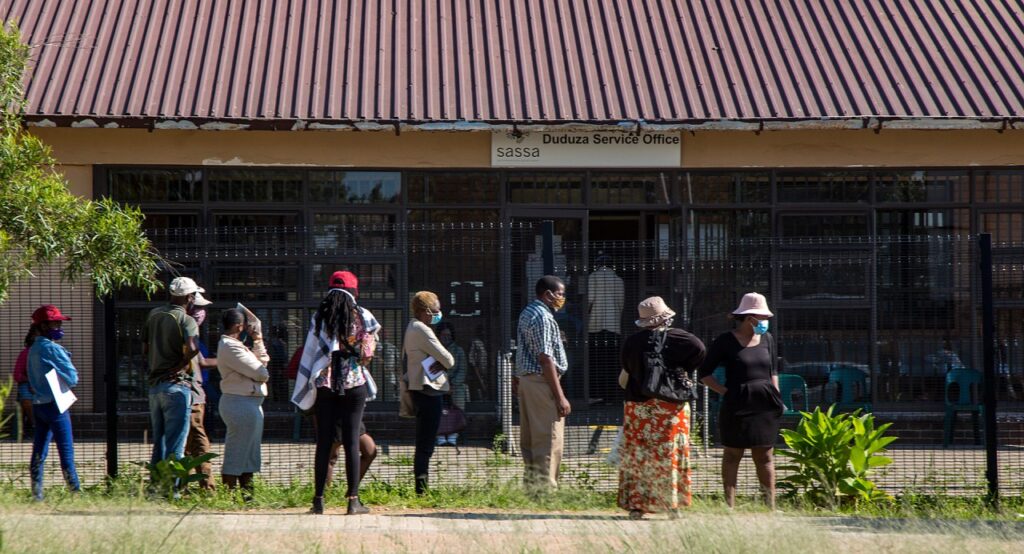Professor Daniel Meyer is a lecturer in the School of Business and Economics at the University of Johannesburg. He writes in a personal capacity.
Even before the outbreak of the coronavirus disease (Covid-19) pandemic in early 2020, South Africa's economy was already in recession, with consecutive quarters of negative growth. A negative, low-growth environment has a negative impact on tax revenues and employment opportunities.
The so-called terrible trifecta of poverty, unemployment, and inequality had been somewhat contained by 2009, thanks to years of economic growth leading up to the financial crisis of that year. But since 2009, poverty levels have spiraled out of control again. More than 50% of the population lives in poverty, and under expanded definitions, unemployment is estimated to be over 40%.
How can these problems be solved from an economic policy perspective? One of the government's main policies to address high poverty levels is the social security system. While social security subsidies are the government's main poverty relief intervention, secondary poverty relief efforts include free or subsidized housing and essential services.
The social security system has been in place for over 20 years and appears to help poor people survive, but it does not keep people out of the poverty trap. There are five main social grant categories in South Africa: Old Age Pension Grant, Disability Grant, Child Maintenance Grant, Foster Child Grant and Care Dependency Grant. In 2000, approximately 3.9 million South Africans, or 9% of the total population, received one of these subsidies, out of a total population of 44.5 million.
By 2019, the total number of beneficiaries had increased to 18.2 million people, which was an astonishing 31% of the total population. From 2000 to 2019, the increase in the number of beneficiaries was 19% each year. Rapidly rising unemployment rates are putting enormous pressure on social security systems. An additional one million people are predicted to have fallen into poverty since the coronavirus outbreak.
The child support subsidy category is the largest, with 13 million people currently receiving it. This situation requires urgent attention. These numbers do not include adults over the age of 18 who are unemployed. That number is estimated at 10.3 million.

Number of social grant beneficiaries. The increase rate is in parentheses.
Statistics South Africa established a poverty line in 2019.
- food poverty line: R561 per person per month. It is estimated that 25% of people live below this line. It was also calculated that it costs R527 to feed a child a nutrition basket and R670 for an adult male.
- lower limit of poverty line: R810 per person per month.and
- Upper poverty line: R1,227 per person per month. An estimated 55% of people live below this line.
According to National Treasury, R195.5 billion will be allocated to social grants in the 2021/22 financial year, which is expected to increase to R205.3 billion in 2022/23. Spending on social grant categories for 2021/22 is as follows: Old Age Pension (R86.5 billion), Disability Grant (R23.6 billion), Child Maintenance Grant (R73.3 billion), Foster Child Grant (R4.3 billion), Care Dependency Grant (R3.7 billion). Social security accounts for approximately 10.9% of the government budget.
To put this into perspective, government debt servicing also accounts for 10% of total budget spending. By comparison, spending on higher education is 5%, spending on the overall health care system is 12%, and all economic development related spending is only about 10%. Are current social grant systems effective in alleviating poverty and are they financially sustainable?
SCritics believe that subsidies only keep people content in poverty, not lift them out of it. The system actively contributes to supporting the survival of poor and vulnerable people and acts as an income redistribution tool. It also allows limited access to essential services to be improved, contributing to higher levels of consumption and savings, as well as improved livelihoods. The subsidies appear to have positive economic and social effects.
The system encourages dependence on the state, misuse and spending of funds on non-essential goods and services, subsidies used to buy votes, and increased teenage pregnancies to obtain child subsidies. has been criticized for doing so.
What are the options? And what is the opportunity cost of the budget spent on social protection? Is it possible to allocate funds more effectively to positively impact poverty, unemployment and inequality in South Africa? Can't you?
From the above analysis, it is clear that poverty and unemployment are out of control, especially among young people. The social security subsidy system, which has over 19 million beneficiaries, is also not sustainable from a cost perspective. The system will be allocated a budget of R250 billion once additional COVID-19 grants are added. What options and support are available?
One thing is certain: this country cannot continue with its growing poverty and unemployment, and its associated culture of dependence on subsidies and social welfare support. People need to secure income through work and escape from the poverty trap.
Combining the total number of social security subsidy recipients and unemployed people, 29.3 million people, or 50%, out of a total population of 59 million, are in need of financial support. This situation has also reached the limit of crisis. Currently, only 11% to 13% of the working population pays taxes on income above the tax threshold, and there is evidence that this tax base is shrinking as high-income residents leave the country due to already high tax rates. there is. Seeking better opportunities abroad.
The proportion of social security recipients to the population needs to be reduced. This could be possible through various initiatives such as high economic growth. A basic income guarantee policy program is proposed for unemployed working-age people aged 18 to 65. 10.3 million people are unemployed in South Africa. A significant portion of the workforce is unproductive, posing a significant risk of rebellion.
Basic income subsidies may be linked to the upper poverty line. Although this amount is R1,227 per month, much lower than the minimum wage of R3,500, it still motivates people to work instead.
New Finance Minister Enoch Godongwana believes people, especially those aged between 18 and 35, need to work and should not be dependent on the government through subsidies. Youth unemployment has also risen uncontrollably from 28% to 63% between 1995 and 2021. The amount needed to support the unemployed could range from R150 billion to R200 billion a year.
A basic income subsidy would require an increase in value-added tax, a possible wealth tax (although the tax rate is already too high compared to other countries), a reallocation of budget from other government sectors such as education and health, and more It has to be financed through loans (which is also a problem since government debt is also spiraling out of control).
People should not be able to receive a basic income subsidy for more than three years. It is proposed that the Expanded Public Works Program for Youth (EPWP) be implemented as a public-private partnership. This allowed the young man to work her three days a week and receive skills training for his remaining two days. This should include technical and IT training. This process may also include internships and mentorship programs.
The work of EPWP's Youth Brigades should include environmental cleaning of foreign trees and trash, infrastructure maintenance such as road and railway repairs, and teaching and assistantship in clinics and hospitals.
Work is the foundation of the economy and society. They allow the achievement of life goals and dignity, create a sense of worth and dignity. Large-scale job creation is possible only with high levels of economic growth, and it must be inclusive.
On the other hand, rising unemployment will ultimately lead to a decline in economic and social welfare. revolution. Young people who are able to work need to be taken care of. Among the many factors hindering job creation, highly restrictive labor regulations are one of the main ones. Some relaxations are proposed to allow for a more flexible labor market.
The war on poverty could be won if economic opportunities were more accessible. People had improved and appropriate skills to compete in the labor market. They had stable incomes and access to good basic essential services. had access to decent housing and assets; and whether governments ensure that they create an enabling environment for business and community success. DM
![]()

